Union Pacific Heritage Fleet
The Union Pacific Heritage Fleet includes commemorative and historic equipment owned by the Union Pacific Railroad. The fleet consists of 13 specially-painted diesel locomotives, four historic diesel locomotives, two steam locomotives, and nearly four dozen passenger cars used on office car specials and excursion trains.
.jpg.webp)
.jpg.webp)
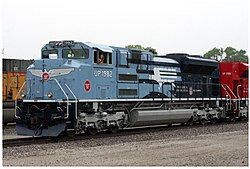
Locomotives
Heritage units
Six EMD SD70ACe locomotives are painted in the liveries of railroads acquired by Union Pacific. The company says the locomotives "pay homage to those railroads and the generations of men and women who helped to build a great nation and the foundation for our future".[2]
- Union Pacific 1982: Serial number 20046610-071, painted in Missouri Pacific Railroad colors. EMD delivered it on May 29, 2005, to UP. The locomotive was unveiled together with number 1983 in a private ceremony on July 30, 2005 in Omaha, Nebraska, after which it entered regular revenue service.[3]
- Union Pacific 1983: Serial number 20046610-075, painted in Western Pacific Railroad colors. Delivered on June 6, 2005; unveiled with UP 1982 on July 30, 2005, after which it entered regular revenue service. As UP 1982, it has a C-C wheel arrangement with a standard track gauge of 4 ft 8 1⁄2 in (1,435 mm).[3]
- Union Pacific 1988: Serial number 20046610-088, painted in Missouri–Kansas–Texas Railroad or "Katy" colors. Delivered on June 15, 2005, unveiled in early August 2005, after which it entered regular revenue service on August 4, pulling a train from Chicago to East St. Louis.[3][4]
- Union Pacific 1989: Serial number 20056723-098, painted in Denver and Rio Grande Western Railroad colors. Delivered on May 24, 2006, unveiled on June 17, 2006, at a special UP employee event in Denver, Colorado.[3][5]
- Union Pacific 1995: Serial number 20056723-099, painted in honor of Chicago and North Western Railway, which became a part of Union Pacific in 1995. The locomotive, painted at the Horicon, Wisconsin, shops of Wisconsin and Southern Railroad, was unveiled at a private ceremony for UP's ex-CNW employees at Proviso Rail Yard in suburban Chicago on July 15, 2006, before being publicly displayed at North Western Station (C&NW's former station) in Chicago. After its unveiling, the locomotive pulled freight train MPRCB from Proviso to Council Bluffs, Iowa, in conjunction with CNW 8646 and 8701 (a set of GE Dash 9-44CW locomotives at the time still in CNW paint). The 1995 then entered regular revenue service, eventually operating through Iowa, Wisconsin, and Minnesota. In 2020, the locomotive suffered some electronic issues and was put out of service. Union Pacific does not know if they will put it back to service or not at this period in time. [3][6]
- Union Pacific 1996: Its paint scheme is based on both the Daylight and "Black Widow" paint schemes of the Southern Pacific Railroad. It was unveiled on August 19, 2006, and is currently operating in regular revenue service. Southern Pacific 6051, a Daylight-painted EMD E9 locomotive that is preserved at the California State Railroad Museum was in attendance at UP 1996's unveiling. UP 1996's road number was previously held by an SD40-2 (originally UP 3339), which was repainted and renumbered for the 1996 Olympics.[3][7] On January 26, 2014, No. 1996 helped move "Big Boy" locomotive No. 4014 from Pomona, California, to West Colton, California.[8] The locomotive pulled the Big Boy out of the Los Angeles County Fairplex, and continued to provide power for the rest of the trip, along with SD70M 4884 and SD40-2s 1596 and 1736.[7]
- Heritage Fleet locomotives
.jpg.webp) Union Pacific 1982 in Chicago (May 7, 2011).
Union Pacific 1982 in Chicago (May 7, 2011)._(cropped).jpg.webp) UP 1983 leads a southbound freight through Pryor, Oklahoma (March 6, 2010).
UP 1983 leads a southbound freight through Pryor, Oklahoma (March 6, 2010).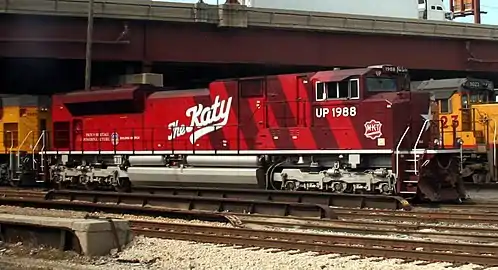 UP 1988 in the engine service facility just south of Chicago's Union Station (August 4, 2007).
UP 1988 in the engine service facility just south of Chicago's Union Station (August 4, 2007)..jpg.webp) UP 1989 in Oregon (June 27, 2010).
UP 1989 in Oregon (June 27, 2010).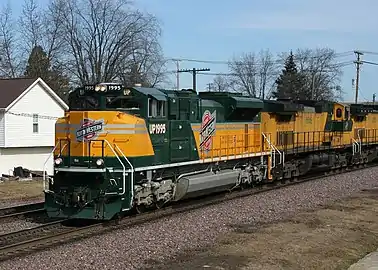 UP 1995 leads the last two un-repainted CNW Dash 9 locomotives westbound through Rochelle Railroad Park (March 3, 2007).
UP 1995 leads the last two un-repainted CNW Dash 9 locomotives westbound through Rochelle Railroad Park (March 3, 2007)..jpg.webp) UP 1996 wearing its "Southern Pacific Railroad" theme (August 31, 2007).
UP 1996 wearing its "Southern Pacific Railroad" theme (August 31, 2007).
Community service
Six locomotives are painted to honor various people, organizations, and sports events:
- Union Pacific 1111: An EMD SD70ACe locomotive painted to honor the employees of the Union Pacific Railroad.[9] It wears the words "Powered by our People" just under the windows, while 1111 was moved forward on to the short hood.[10]
- Union Pacific 1943: An EMD SD70AH locomotive painted to honor the United States Armed Forces.[11] It wears the name "The Spirit of the Union Pacific" as a nod to a bomber shot down in WW2 in the year 1943.[12]
- Union Pacific 2001 and Union Pacific 2002: Two EMD SD70M locomotives painted for the 2002 Olympic Winter Games.[13]
- Union Pacific 2010: A GE ES44AC locomotive painted to honor the Boy Scouts of America's 100th Anniversary.[14][15]
- Union Pacific 7400: A GE ES44AC unit painted to honor the Susan G. Komen for the Cure organization, and the many people–employees, family, friends and community members–affected by breast cancer.[16][17]
Five locomotives painted to honor sports events, one organization, a military victory and a U.S. President have been retired or repainted in standard Union Pacific livery:
- Union Pacific 1896 and Union Pacific 1996: Two SD-40-2 locomotives rebuilt and repainted in 1996 for the Centennial Olympic Games in Atlanta. From April 30 to June 3, the 19-car Olympic Torch Relay train featured a specially designed "cauldron car" that transported the Olympic flame across much of the western United States. The number 1996 has since been given to the Southern Pacific Heritage Unit.[18]
- Union Pacific 3300: An SD40-2 locomotive painted in a red, white and blue paint scheme to publicize the 1994 United Way campaign. Unveiled on August 18, 1994.[19]
- Union Pacific 3593: An SD40-2 locomotive painted in a camouflage tan and brown livery. Nicknamed the "Desert Victory Locomotive," it was unveiled on February 27, 1991, following the first Gulf War.[20]
- Union Pacific 4141: An EMD SD70ACe locomotive painted to honor George H. W. Bush, the 41st President of the United States. The unit was removed from active service in 2007 and stored in North Little Rock until 2018, when it returned to power George H. W. Bush's funeral train after his death in November 2018. Following the tour, it returned to active service and continued to run until November 2019, when the Union Pacific donated it to the George H.W. Bush Presidential Library and Museum for eventual display.[21][22][23][24]
- Community Service locomotives
.jpg.webp) UP 1111 and 4141 on display in Omaha, Nebraska
UP 1111 and 4141 on display in Omaha, Nebraska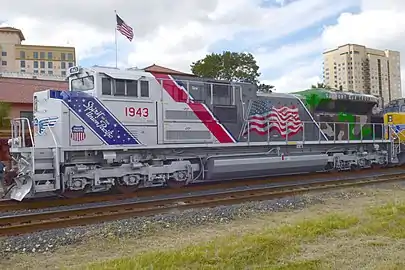 UP 1943 on a business train (2017)
UP 1943 on a business train (2017).jpg.webp) UP 2002 in Ogden, Utah (2009)
UP 2002 in Ogden, Utah (2009)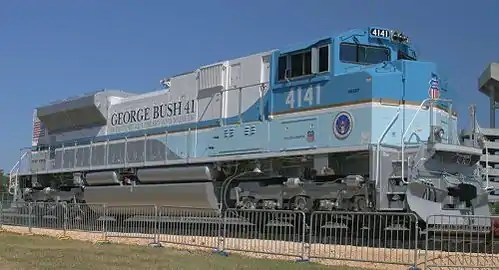 UP 4141 (now retired) at the George Bush Presidential Library (2005)
UP 4141 (now retired) at the George Bush Presidential Library (2005)
EMD E9 Streamliners
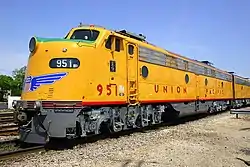
UP 949, 951 and 963B are a trio of streamlined General Motors Electro-Motive Division E9 passenger locomotives built in 1955. They are used to haul the UP business cars during excursions and charter specials. While externally they are 1955 vintage locomotives, the original twin 1,200-hp 12-cylinder 567 series engines have been replaced with single EMD 16-645E 2000 hp (1.5 MW) engines and the electrical and control equipment similarly upgraded, making them more compatible with more modern locomotives.[25] The set is made of two A units and one B unit, the latter which contains an HEP engine-generator set for powering passenger cars. The two A units have been modified to eliminate the nose doors to increase safety in a collision.
UP 951 has carried its original number since its entry into service. UP 949 was built with its current number, but later was sent to the Chicago and North Western Railway and Regional Transportation Authority as CNW/RTA #511 before being reacquired by the UP.[26] UP 963B was built as UP E9B 970B and served as a heater car on Amtrak upon its formation before being reacquired by the UP. The heater car number was AMTK 669/1919.[27]
EMD DDA40X Centennial
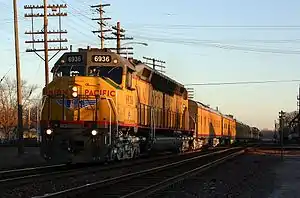
UP 6936 is an EMD DDA40X "Centennial" diesel-electric locomotive, the last of its class in service. These were the largest diesel locomotives ever built and were manufactured specifically for UP.[28] In November 2000, UP 6936 collided with a dump truck at a grade crossing in Livonia, Louisiana, damaging its front end. The unit was stored in North Little Rock, Arkansas, until the damage could be repaired.[29] Another collision took place in 2007, though there were no injuries.[30]
Steam locomotives
Since 1960, the Union Pacific has operated steam locomotives on a variety of excursions. These include:[31]
- UP 844: a 4-8-4 Northern type express passenger steam locomotive (class FEF-3), operated in excursion service since 1960. It was the last steam locomotive built for UP and has been in continuous service since its 1944 delivery. Many people know the engine as the No. 8444, since an extra '4' was added to its number in 1962 to distinguish it from a diesel numbered in the 800 series. It regained its rightful number in June 1989, after the diesel was retired and donated to the Nevada Southern Railroad Museum in Boulder City, Nevada. A mechanical failure occurred on June 24, 1999, in which the boiler tubes from the 1996 overhaul, being made of the wrong material, collapsed inside the boiler and put the steam locomotive out of commission. The UP steam crew repaired it and returned it to service on November 10, 2004. It was rebuilt again in 2015 and returned to service in 2016. In addition to being one of UP's oldest locomotives, it is the only steam locomotive to never be officially retired from a North American Class I railroad.[1]
- UP 4014: a 4-8-8-4 Big Boy class freight steam locomotive, began operating in excursion service in 2019. It is the largest operational steam locomotive in the world. Delivered in 1941, the locomotive operated in revenue service until it made its last run on July 21, 1959, and was placed in storage until it was officially retired in 1961. Following retirement, it was donated in late 1961 to the RailGiants Train Museum in Pomona, California, where it became one of the eight Big Boys preserved around the United States. On July 23, 2013, it was announced that the UP was acquiring UP 4014 from The Southern California Chapter of The Railway and Locomotive Historical Society in Pomona, with the goal of restoring it to service. No. 4014 was moved from Pomona to the Union Pacific West Colton yard on January 26, 2014, and then to Cheyenne, Wyoming from April 28, 2014 to May 8, 2014. Restoration to full operating condition was completed in May 2019, with its first excursion called "The Great Race to Ogden" taking place during the same month.[32]
One steam locomotive, which previously operated in excursion service, has since been retired:
- UP 3985: a 4-6-6-4 Challenger class dual-service steam locomotive, operated in excursion service from 1981 to 2010 and currently retired as of January 2020. Delivered in 1943, it operated in revenue service until it was withdrawn from service in 1962. Following retirement, it was stored in the UP roundhouse until 1975, when it was moved to the employees' parking lot outside the depot in Cheyenne, Wyoming. It sat on display until 1979, when a team of employee volunteers restored it to service in 1981.[33] Following the restoration, it was the largest operating steam locomotive in the world until it lost the title to UP 4014. In 2007, it underwent repairs for service, and was back up and running in 2008 to continue its run, but further mechanical problems caused it to be placed back into storage in October 2010. It was subsequently retired in January 2020 following 4014's restoration and is now stored at the roundhouse in Cheyenne.[34][35][36]
- Heritage steam locomotives
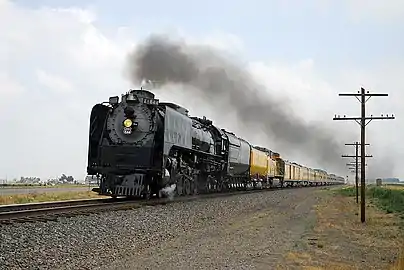 UP 844 running through Platteville, Colorado on July 19, 2007.
UP 844 running through Platteville, Colorado on July 19, 2007.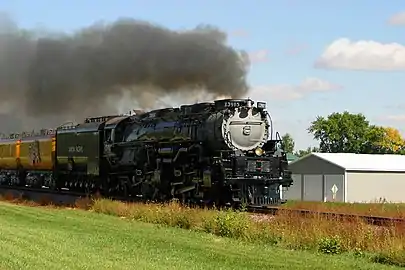 UP 3985 (now retired) running through Alton, Iowa on October 1, 2008.
UP 3985 (now retired) running through Alton, Iowa on October 1, 2008..jpg.webp) UP 4014 running through Friesland, Wisconsin, on July 25, 2019.
UP 4014 running through Friesland, Wisconsin, on July 25, 2019.
Passenger cars
The Union Pacific operates a fleet of passenger cars that are often used for excursions and office car specials. Originally ordered by a variety of railroads, the oldest dates to 1912, but most were built in the mid-20th century, at the height of passenger train service. The fleet also carries a variety of important people, such as presidents, senators, generals, soldiers, artists, architects, singers and actors.[37]
Baggage
- No. 5769 Council Bluffs: built in 1962 as a postal storage car. It was converted for use as a baggage recreation car for a special train sent to the U.S. political conventions in 2000.[38] On December 6, 2018, the car carried the casket of George H. W. Bush to College Station, Texas. It currently wears a large American Flag wrap on both sides.
Business
- No. 5449 Arden: built in 1950 as a standard coach, rebuilt in 1952 as a business coach.[39]
- No. 102 Cheyenne: built in 1950 as a five-bedroom lounge car called the Baker. It was rebuilt as business car No. 102 in 1965, and named the Cheyenne in 1989.[40]
- No. 114 Feather River: built in 1956 as a five-bedroom lounge car called Boise. In 1963, this car was converted to business car No. 114.[41]
.jpg.webp)
- No. 99 Kenefick: built in 1950 as coach No. 5446. It was rebuilt to business car no. 99 in 1963, and officially named the Kenefick in 1988.[42]
- No. 101 Lone Star: built in 1950 as coach No. 5447. It was rebuilt in 1957 to the business car No. 100. It was renumbered in 1965 to No. 103 and again in 1968 to No. 102 and in 1971 to No. 101. In 1989 the car was named Pocatello, after Shoshoni tribal Chief Pocatello, who granted the right of way for Union Pacific pioneer subsidiary Oregon Short Line to build across Native American land in southeastern Idaho. The car received an extensive interior wood upgrade and was renamed Lone Star in 2001 in recognition of UP's operations in Texas, the Lone Star state.[43]
- No. 104 North Platte: built in 1926 as the Los Angeles and Salt Lake Railroad's Observation car No. 4403. The car was rebuilt in 1942 as Cafe Observation car No. 1563. In 1945, the car was remodeled and became LA&SL business car No. 123. The car was renumbered to No. 102 in 1952 and to No. 104 in 1957. No. 104 was remodeled in 1968 and stored in 1990. The car was brought out of storage, remodeled and named the North Platte in 1995.[44]
- No. 101 Selma: built in 1912. It is the oldest car in the UP Heritage Passenger fleet. The car was sold to the Western Pacific, but was returned to Union Pacific's roster with the merger in 1982. It was assigned to the Missouri Pacific and finally named Selma in 1987.[45]
- No. 106 Shoshone: built in 1914 as business car No. 99 for then Union Pacific Chairman Robert Lovett. It was renumbered No. 106 in June 1952, and named Shoshone in 1978. It was donated to the California State Railroad Museum in 1985. Shoshone was loaned back to Union Pacific in 1992 in exchange for business car No. 103.[46]
- No. 100 St. Louis: built in 1950 as 44-seat coach No. 5448. It was rebuilt into business car No. 100 in May 1952, and was named the St. Louis in 1989. In 2010, the car was remodeled with a wood interior.[47]
Club Lounge
- No. 6203 Sun Valley: built in 1949 by American Car & Foundry as club lounge No. 6203, then named the Colorado River, a part of the Rivers rail car series, which featured barber shops and valet service. The car was rebuilt in 1959, and the barber shop and valet areas were converted into card rooms. The car was named Sun Valley in 1989.[48]
Coach
- No. 5486 City of Salina: built in 1953 as 44-seat coach No. 5486. It was named the City of Salina in 1992.[49]
- No. 5468 Katy Flyer: built in 1953 as 44-seat coach No. 5468. It was renamed the Katy Flyer in 1993.[50]
- No. 5473 Portland Rose: built in 1953 as 44-seat coach No. 5473. It was renamed the Portland Rose in 1990.[51]
- No. 5480 Sunshine Special: built in 1954 as 44-seat coach No. 5480. It was named Sunshine Special in 1989.[52]
- No. 5483 Texas Eagle: built in 1953 as 44-seat coach No. 5483. It was named the Texas Eagle in 1990.[53]
Concession
- No. 5818 Reed Jackson: built in 1961 by the St. Louis Car Company as Railroad Post Office (RPO) UP5818. It was converted into a maintenance of way tool car in 1968 and then into a maintenance of way kitchen car in 1981. The car became part of the Heritage Passenger Fleet in 1992 and was converted into the concession car Sherman Hill that same year. In August 2009, the car was renamed the Reed Jackson, in honor of the Union Pacific Steam Team's conductor who suddenly passed away on August 15, 2009.[54]
Deluxe Sleeper
- No. 1602 Green River: built in 1949 as the 12-roomette, four-bedroom sleeper, the No. 1602 Western Hills. It was rebuilt in 1965 to an 11-bedroom sleeper, Sun Isle. In 1991, the car was reconfigured into an eight-bedroom deluxe sleeper and renamed the Green River.[55]
- No. 413 Lake Bluff: built for the Kansas City Southern Railway in 1965 as coach No. 272. The coach was sold to the New Jersey Department of Transportation in 1972 and renumbered No. 5342. The Chicago and North Western acquired it in 1986, renumbered it to No. 413, and was renamed Lake Bluff. The Lake Bluff was an eight-bedroom sleeper that became part of Union Pacific's Heritage Passenger Fleet as the result of the 1995 Union Pacific and C&NW merger. It was reconfigured as a deluxe four-bedroom sleeper in 2008.[56]
- No. 412 Lake Forest: built in 1965 as a 72-seat coach for the Kansas City Southern Railway and numbered No. 270. In 1972, it was sold to the New Jersey Department of Transportation and renumbered No. 5341. The coach served in New Jersey area commuter service until 1986, when it was sold to the Chicago & North Western. The C&NW rebuilt the car into an eight-bedroom stateroom sleeper, No. 412, and was named Lake Forest. Union Pacific acquired the Lake Forest in 1995 as a result of the C&NW merger. It was reconfigured as a deluxe four-bedroom sleeper in 2008.[57]
- No. 1612 Little Rock: built in 1949 as the 12-roomette, four-bedroom sleeper Western Scene. It was rebuilt to an 11-bedroom sleeper, No. 1612 Sun Villa, in 1965. It was renamed the North Platte in 1990, and finally Little Rock in 1995. The car was rebuilt as a four-bedroom deluxe sleeper in 2008.[58]
- No. 1608 Omaha: built in 1949 as the 12-roomette, four-bedroom sleeper called the Western Star. It was rebuilt in 1965 to an 11-bedroom sleeper, No. 1608 Sun Rest, and rebuilt again in 1974 to an eight-bedroom sleeper and renamed the Omaha.[59]
- No. 4003 Pacific Limited: built in 1955 as cafeteria lounge No. 4003, one of only four cars in that configuration for Union Pacific. As the name implies, it had a typical lunch counter in addition to regular seating. It was reacquired by Union Pacific in 1993 and named Pacific Limited. In 2012, the car was reconfigured into a four-bedroom deluxe sleeper.[60]
- No. 1610 Portola: built in 1949 as a 12-roomette, four-bedroom sleeper, named the Western Valley. It was rebuilt in 1965 to an 11-bedroom sleeper, the No. 1610 Sun Skies. In 1989, the car was converted into an eight-bedroom sleeper and renamed the Portola". It received a full wood interior upgrade in 2004.[61]
- No. 1605 Powder River: built in 1949 as a 12-roomette, four-bedroom sleeper named Western Plains. It was rebuilt in 1965 into an 11-bedroom sleeper named Sun Manor. In 1989 it was rebuilt into a four-bedroom deluxe sleeper and renamed the Powder River. It received a full wood interior upgrade in 2003.[62]
- No. 1603 Wyoming: built in 1949 by as the 12-roomette, four-bedroom sleeper named Western Lodge. It was rebuilt in 1965 into an 11-bedroom sleeper No. 1603, Sun Lake. In 1974 it was rebuilt into a four-bedroom deluxe sleeper and renamed Wyoming.[63]
Diner
- No. 5011 City of Denver: built in 1959 as lunch counter cafe and lounge No. 5011. It was sold to Golden Wool Co. in 1972. Union Pacific reacquired the car in 1989, when it was rebuilt into a 36-seat dining car and named the City of Denver.[64]
- No. 4808 City of Los Angeles: was built in 1949 as 48-seat diner No. 4808. The car still retains its original configuration and was named the City of Los Angeles in 1991.[65]
- No. 5015 Overland: built in 1949 as lunch counter cafe and lounge No. 5015. It was rebuilt as a 36-seat diner in 1988. It received a wood interior upgrade in 2005.[66]
Dome Coach
.jpg.webp)
Dome Diner
- No. 8008 City of Portland: one of ten dome cars built in 1955. Union Pacific reacquired the car in 1990 and rebuilt it for excursion service. The car was named City of Portland after the famous streamliner passenger train.[69]
- No. 8004 Colorado Eagle: built in 1955 as dome diner No. 8004. It was reacquired by Union Pacific in 1993 and named the Colorado Eagle after the synonymous streamliner, which began service on the Missouri Pacific Railroad on June 21, 1942.[70]
- No. 7011 Missouri River Eagle: built in 1958 as dome coach No. 7011. In 1993, it was named the Missouri River Eagle, after a Missouri Pacific Railroad passenger train. The car was converted to a dome diner in the mid 1980s by Transico, an excursion train operator. UP repurchased the car in the early 1990s.[71]
Dome Lounge
- No. 9009 City of San Francisco: built in 1955 as dome lounge No. 9009 and named in 1993. An Astra Dome car, it is the only dome lounge in the Union Pacific Heritage Passenger Fleet that is still configured for end-of-train service. The car still has windows in the back wall, and the necessary exterior lighting so it can be used as the last car of a train.[72]
- No. 9004 Harriman: built in 1955 as dome lounge No. 9004. It was remodeled and named Harriman in 1988. This car received a full wood interior upgrade in 2006. The car is named in honor of Edward Harriman, an American railroad executive and the president of the Union Pacific Railroad from 1904 to 1909.[73]
- No. 9005 Walter Dean: built in 1955 as dome lounge No. 9005. It was sold to the Auto-Train Corporation, then reacquired by Union Pacific and named the Walter Dean in 1990. The car is named for Walter Dean, who began his service with Union Pacific in 1942 as a dining car waiter on the Challenger.[74]
Crew Car/Crew Sleeper
- No. 202 Willie James: built in 1949 as a 10-roomette, six-bedroom sleeper named the Pacific Domain. In 1973, it was rebuilt and named No. 202. The car was renamed the Cabarton in 1980 by John C. Kenefick, then Union Pacific's president, in honor of R.L. Richmond, Union Pacific's then vice president of operations. The car was renamed Willie James in January 2009 to honor long-time business car chef Willie James.[75]
- No. 314 Columbia River: built in 1949 as the Western Wonderland, a 12-roomette (single), four-bedroom sleeper. It was converted to an 11-bedroom car, the No. 1611 Sun Slope, in 1965. The car resembles traditional passenger sleeping cars because upper berths still remain in some rooms. In 1989, it was named the Columbia River.[76]
Inspection
- No. 420 Fox River: built in 1954 as a two-bedroom, two-compartment, buffet-lounge-sleeper for the Canadian National Railway. In 1984, Milwaukee Rail Car reconstructed it into a theater inspection car.[77]
- No. 203 Idaho: built in 1949 as a 12-roomette, four-double bedroom car named the Western Mountain. It was rebuilt in 1965 as an 11-bedroom sleeper named Sun Lane, and was converted to the inspection car Idaho in 1980.[78]
Power
- 207: built in 1949 as boiler/baggage/dormitory car No. 6004. It was later rebuilt as steam generator dormitory car No. 303, and renumbered to Nos. 207 in 1987.
- 208: Nos. 207 and 208 in 1949 as boiler/baggage/dormitory car No. 6006. It was later rebuilt as steam generator dormitory car No. 304, and renumbered to No. 208 in 1987.
- 2066: built as postal storage car No. 5816.[79]
Tool Car
- No. 6334 Art Lockman: built in 1962 as baggage car No. 6334. It was one of the last baggage cars purchased by Union Pacific. The car was converted to a tool car for snowplow service and renumbered No. 904304 in 1973. It was assigned to the Heritage Passenger Fleet in 1981. The car was named Art Lockman in 1992 and was renumbered UPP 6334 in 2003.[80]
Museum
- No. 5779 Promontory: built in 1962 as postal storage car No. 5779. It is the newest car in Union Pacific's Heritage Passenger Fleet. The car was renamed the Promontory in 1993, and was converted to a museum car originally designed for the Wyoming-Idaho Centennial train. Carpeted walls permit exhibits to be changed to reflect special needs. When not in use for displays, it is often equipped as an exercise car for long trips. In celebration of Union Pacific's 150th anniversary, the Building America exhibit was installed. The state-of-the-art traveling museum told the story of building the Transcontinental railroad through interactive touch-screen monitors, large display graphics and artifacts.[81] In 2019, the Promontory was converted again into the Experience the Union Pacific car, a brand new, multi-media walk-through exhibition that provides a glimpse at the past while telling the story of modern-day railroading.[82]
References
- ""Living Legend" Northern No. 844". www.up.com. Retrieved July 19, 2019.
- "Union Pacific Announces Heritage Series Locomotives". Union Pacific. July 30, 2005. Archived from the original on August 16, 2017. Retrieved May 7, 2019.
- Strack, Don (2006). "All Time UP Diesel Roster, part 32". Utah Rails.net. Retrieved July 14, 2006.
- Union Pacific Railroad (September 20, 2005). "Union Pacific Introduces Katy Heritage Series Locomotive". Retrieved July 11, 2006.
- Union Pacific Railroad (June 19, 2006). "Denver & Rio Grande Western Colors Again Ride the Rails". Retrieved June 19, 2006.
- Union Pacific Railroad (July 17, 2006). "New Union Pacific Locomotive Honors Men and Women of Chicago & North Western Railroad". Retrieved July 17, 2006.
- "New Union Pacific Locomotive Honors Men and Women of Southern Pacific Railroad" (Press release). Union Pacific Railroad. August 21, 2006. Retrieved August 22, 2006.
- "Fans Welcome Big Boy No. 4014's Return to the National Rail Network". Community Ties. Union Pacific. January 27, 2014. Archived from the original on May 8, 2017. Retrieved May 8, 2019.
- "No. 1111 - Employee Pride Locomotive". www.up.com. Retrieved July 19, 2019.
- "No. 1111 - Employee Pride Locomotive". www.up.com. Retrieved August 23, 2019.
- "No. 1943 - The Spirit Locomotive Honoring U.S. Armed Forces". www.up.com. Retrieved July 19, 2019.
- "No. 1943 - The Spirit Locomotive Honoring U.S. Armed Forces". www.up.com. Retrieved August 23, 2019.
- "Salt Lake 2002 Olympic Winter Games Locomotives". www.up.com. Retrieved July 19, 2019.
- "No. 2010 - Boy Scouts of America Commemorative Locomotive". www.up.com. Retrieved July 19, 2019.
- "Union Pacific Railroad Unveils No. 2010 Boy Scouts of America Commemorative Locomotive". www.uprr.com. Retrieved July 22, 2019.
- "No. 7400 - Union Pacific Pink Ribbon Locomotive". www.up.com. Retrieved July 19, 2019.
- "Union Pacific Railroad Unveils Its Pink Ribbon Locomotive". www.uprr.com. Retrieved July 22, 2019.
- "Atlanta 1996 Centennial Olympic Games Torch Relay Locomotives". www.up.com. Retrieved July 19, 2019.
- "No. 3300 - United Spirit Locomotive Promoting United Way". www.up.com. Retrieved July 19, 2019.
- "No. 3593 - Desert Victory Locomotive". www.up.com. Retrieved July 19, 2019.
- November 8, Jim Wrinn |; 2019. "Union Pacific donates SD70ACe No. 4141 to George H.W. Bush Presidential Library; Big Boy 4014 joins celebration | Trains Magazine". TrainsMag.com. Retrieved November 8, 2019.CS1 maint: numeric names: authors list (link)
- "No. 4141 - President George H. W. Bush Commemorative Locomotive". www.up.com. Retrieved July 19, 2019.
- Lozano, Juan a (October 18, 2005). "Union Pacific unveils locomotive named for Bush 41". Plainview Daily Herald. Retrieved July 22, 2019.
- "Union Pacific Railroad Honors President Bush 41 With Custom-Painted Locomotive". Union Pacific. Retrieved July 22, 2019.
- "E-9 Streamliners". www.up.com. Retrieved July 19, 2019.
- "Pictures of UP 949". Railroad Picture Archives.
- "Pictures of UP 963B". Railroad Picture Archives.
- "Centennial DD40X". www.up.com. Retrieved July 19, 2019.
- "Wreck damaged UP 6936 sitting in North Little Rock, Ark, December 7, 2000". TrainWeb. Retrieved June 8, 2019.
- "Accident Investigation Report HQ-2007-29". Federal Railroad Administration Office of Safety. May 16, 2007. Retrieved February 10, 2017.
- "UP Steam". www.up.com. Retrieved July 19, 2019.
- "Union Pacific Railroad Acquires Big Boy Locomotive No. 4014". Union Pacific. July 23, 2013. Archived from the original on June 24, 2018. Retrieved April 30, 2019.
- "Challenger No. 3985". www.up.com. Retrieved July 19, 2019.
- Keefe, Kevin. "The Challenger at high tide". Classic Trains.
- "Union Pacific No. 3985's next stop". Retrieved April 5, 2020.
- Union Pacific Permanently Retires Challenger 4-6-6-4 Steam Railway issue 503 March 2020 page 21
- "Historical Equipment Still in Use". www.up.com. Retrieved July 19, 2019.
- "Data:Council Bluffs" (PDF). www.up.com. Retrieved January 4, 2020.
- "Data: Arden" (PDF). www.up.com. Retrieved January 4, 2020.
- "Data: Cheyenne" (PDF). www.up.com. Retrieved January 4, 2020.
- "Data: Feather River" (PDF). www.up.com. Retrieved January 4, 2020.
- "Data: Kennefick" (PDF). www.up.com. Retrieved January 4, 2020.
- "Data: Lone Star" (PDF). www.up.com. Retrieved January 4, 2020.
- "Data: North Platte" (PDF). www.up.com. Retrieved January 4, 2020.
- "Data: Selma" (PDF). www.up.com. Retrieved January 4, 2020.
- "Data: Shoshone" (PDF). www.up.com. Retrieved January 4, 2020.
- "Data: St Louise" (PDF). www.up.com. Retrieved January 4, 2020.
- "Data: Sun Valley" (PDF). www.up.com. Retrieved January 4, 2020.
- "Data: City of Salina" (PDF). www.up.com. Retrieved January 4, 2020.
- "Data: Katy Flyer" (PDF). www.up.com. Retrieved January 4, 2020.
- "Data: Portland Rose" (PDF). www.up.com. Retrieved January 4, 2020.
- "Data: Sunshine Special" (PDF). www.up.com. Retrieved January 4, 2020.
- "Data: Texas Eagle" (PDF). www.up.com. Retrieved January 4, 2020.
- "Data: Reed Jackson Historical" (PDF). www.up.com. Retrieved January 4, 2020.
- "Data: Green River" (PDF). www.up.com. Retrieved January 4, 2020.
- "Data: Lake Bluff" (PDF). www.up.com. Retrieved January 4, 2020.
- "Data: Lake Forest" (PDF). www.up.com. Retrieved January 4, 2020.
- "Data: Little Rock" (PDF). www.up.com. Retrieved January 4, 2020.
- "Data: Omaha" (PDF). www.up.com. Retrieved January 4, 2020.
- "Data: Pacific Limited" (PDF). www.up.com. Retrieved January 4, 2020.
- "Data: Portola" (PDF). www.up.com. Retrieved January 4, 2020.
- "Data: Powder River Historical" (PDF). www.up.com. Retrieved January 4, 2020.
- "Data: Wyoming Historical" (PDF). www.up.com. Retrieved January 4, 2020.
- "Data: Denver" (PDF). www.up.com. Retrieved January 4, 2020.
- "Data: City of Los Angeles" (PDF). www.up.com. Retrieved January 4, 2020.
- "Data: Overland" (PDF). www.up.com. Retrieved January 4, 2020.
- "Data: Challenger" (PDF). www.up.com. Retrieved January 4, 2020.
- "Data: Columbine" (PDF). www.up.com. Retrieved January 4, 2020.
- "Data: City of Portland" (PDF). www.up.com. Retrieved January 4, 2020.
- "Data: Colorado Eagle" (PDF). www.up.com. Retrieved January 4, 2020.
- "Data: Missouri River Eagle" (PDF). www.up.com. Retrieved January 4, 2020.
- "Data: City of San Francisco" (PDF). www.up.com. Retrieved January 4, 2020.
- "Data: Harriman" (PDF). www.up.com. Retrieved January 4, 2020.
- "Data: Walter Dean Historical" (PDF). www.up.com. Retrieved January 4, 2020.
- "Data: Willie James Historical" (PDF). www.up.com. Retrieved January 4, 2020.
- "Data: Colombia River" (PDF). www.up.com. Retrieved January 4, 2020.
- "Data: Fox River" (PDF). www.up.com. Retrieved January 4, 2020.
- "Data: Idaho" (PDF). www.up.com. Retrieved January 4, 2020.
- "Data: PCH" (PDF). www.up.com. Retrieved January 4, 2020.
- "Data: Lockman" (PDF). www.up.com. Retrieved January 4, 2020.
- "Data: Documents" (PDF). www.up.com. Retrieved January 4, 2020.
- "Experience the Union Pacific Rail Car". www.up.com. Retrieved July 19, 2019.
| Wikimedia Commons has media related to Union Pacific Railroad Heritage Fleet. |
External links
- Heritage Fleet Home Page